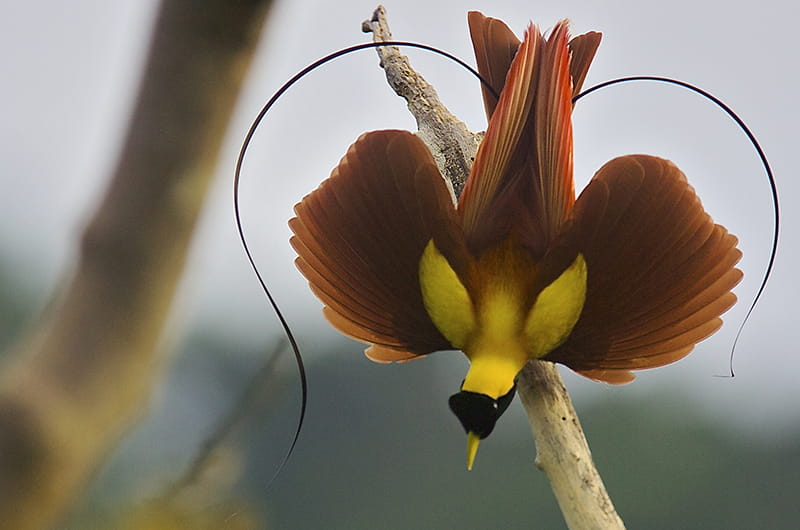New Academy Exhibit Has Amazing Exotic Birds, a Dance-off and a Fancy Hat

- Drexel Environmental Collaboratory Releases Cross-Sector Findings on Severe Weather Recovery Challenges
- How and When Could AI Be Used in Emergency Medicine?
- Video Game Design Reaches New Heights in 'Skyscraper Games'
- MXene Current Collectors Could Reduce Size, Improve Recyclability of Li-Ion Batteries

Travel to New Guinea this spring and follow a real-life adventure to discover exotic birds-of-paradise, an elegant example of extreme evolution, in the highly interactive exhibit Birds of Paradise: Amazing Avian Evolution at the Academy of Natural Sciences of Drexel University.
Found only in New Guinea and parts of Australia, birds-of-paradise are known for their ornate feathers and tail plumes and elaborate mating rituals that include wild calls and crazy courtship dances. Co-developed by the National Geographic Society and the Cornell Lab of Ornithology, Birds of Paradise reveals all 39 known species of these elusive birds and showcases the adventures of the two explorers who conducted groundbreaking research on them.
Birds of Paradise is on view from now through Sept. 1 and is free with regular museum admission.
The fascinating story of these remarkable birds is told through stunning imagery, compelling video, soundscapes, artifacts and engaging interactive activities for both adults and children. Equal parts natural history, photography and science, the exhibit gives visitors an in-depth look at the lives of these birds in an engaging and enlightening way.
“Every section has a hands-on activity, video or interactive component that tells the amazing story of these beautiful birds and the intrepid researchers who tracked them all down in the rain forest,” said Academy Exhibits Senior Director Jennifer Sontchi.
Birds of Paradise is based on the research of National Geographic photographer Tim Laman and Cornell ornithologist Edwin Scholes, who made 18 expeditions over 8 years to the remote, untarnished rain forests of New Guinea. Using film, video and detailed observations, Laman and Scholes documented one of the most elegant examples of extreme evolution, a result of millions of years of sexual selection at work in an environment with plenty of food and no natural predators.
Dance, Dance Evolution
As they enter the exhibit, visitors will meet Laman and Scholes through introductory videos and explore a montage of all 39 bird-of-paradise species. Their research, including new information about each species, is presented in an easy-to-understand format.
“Dance, Dance Evolution” lets people dance along with the birds to learn their signature courtship moves, while the audience casts their votes for the dancer who does the best imitation. The first-ever video of the female’s point-of-view of a male bird’s dances is shown, captured through an innovative use of equipment created by Laman and Scholes.
Photos, videos, bird specimens and a kinetic sculpture of a riflebird (a bird-of-paradise species) show the remarkable transformations the birds undergo to attract mates and the various moves that constitute their mating rituals. Visitors can manipulate artificial tree branches to trigger video footage of different birds displayed on their perches.
The exhibit highlights the importance of birds-of-paradise to New Guinea, where natives still use bird skins as ornaments and currency. Between 1600 and 1914, male birds were collected for their long colorful plumes, which were widely used in Europe to decorate women’s hats. Today birds-of-paradise are protected from commercial trading, though the birds are still vulnerable.
“Birds-of-paradise live in such narrow ranges that cutting a forest or digging a mine or even a natural flood could adversely affect them,” said Nate Rice, PhD, the Academy’s collection manager for ornithology. “All the species are considered vulnerable or threatened.”
Numerous mounted birds, bird specimens and a historic fancy hat, all from the Academy’s collection, are included in the exhibit’s national tour. One special bird-of-paradise in the Academy’s world-renowned Ornithology Collection in Philadelphia was collected by Alfred Russel Wallace, a contemporary of Charles Darwin, who first reported the displays and postures of the species in 1857.
A video and more information about the exhibit are available on the Academy’s website, ansp.org. For more information about the birds-of-paradise research project, visit the websites of the Cornell Lab of Ornithology and National Geographic.
In This Article
Drexel News is produced by
University Marketing and Communications.
